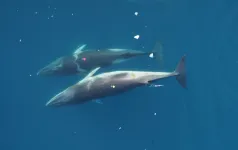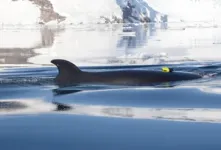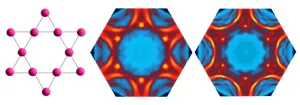(Press-News.org) A new study of Antarctic minke whales reveals a minimum size limit for whales employing the highly efficient “lunge-feeding” strategy that enabled the blue whale to become the largest animal on Earth.
Lunge feeding whales accelerate toward a patch of prey, engulf a huge volume of water, and then filter out the prey through the baleen plates in their mouths. This strategy is used by the largest group of baleen whales, known as rorquals, which includes blue, fin, humpback, and minke whales.
The ability to engulf large amounts of prey-laden water is essential to making this feeding strategy pay off, and the energy efficiency increases with larger body size. An 80-ton blue whale, for example, can engulf a water volume equivalent to 135% of its body mass, whereas a 5-ton minke whale can engulf a volume equal to 42% of its body mass.
In the new study, published March 13 in Nature Ecology & Evolution, researchers used noninvasive suction tags to observe 23 Antarctic minke whales in the waters off the West Antarctic Peninsula, tracking their daytime and nighttime foraging behavior as they fed on Antarctic krill. Data from previous studies of krill-feeding humpback whales and blue whales were used for comparison.
“When we calculate how much energy they use in foraging and what their overall intake should be based on their size, we find that minke whales are right at the threshold,” said first author David Cade, who led the study as a postdoctoral researcher at UC Santa Cruz and is now at Stanford’s Hopkins Marine Station. “Anything smaller than a minke could not achieve the foraging rates necessary to survive.”
Minke whales are not as well studied as other species of baleen whales, in part because they can be harder to find and tag.
“The data in this study represent more information on a poorly studied species than has ever been published previously and is helping us to better understand not only the species, but the role of baleen whales in marine ecosystems,” said coauthor Ari Friedlaender, professor of ocean sciences at UC Santa Cruz. “With so little known about this species that is being impacted by climate change, the more we understand their ecology and behavior the better we can protect them.”
The researchers observed remarkably high feeding rates for minke whales, especially at night, when they were often lunging every 15 seconds or so. Krill come to the surface at night and stay in the depths during the day, so daytime feeding requires deep dives, which are less efficient for smaller animals.
“During the day they feed at depths comparable to humpbacks and blue whales, but their foraging rates aren’t as high because they’re smaller,” Cade said. “Their nighttime feeding rates are two to five times the day rate.”
At night, the smaller, more maneuverable minke whales are well suited for pursuing small, scattered patches of krill at the surface. “When they’re surface feeding, they don’t have to hold their breath during dives and they can do lunges over and over again,” Cade said. “Only at night can they get the really high feeding rates they need.”
The study also addresses questions about the evolution of baleen whales and the origins of a feeding strategy that depends on large body size. Lunge feeding is thought to have arisen first in whales about the size of today’s Antarctic minke whales. This enabled the evolution of whales with gigantic body sizes, such as blue whales, during the past 5 million years when changing ocean conditions led to the formation of predictable regions with large prey patches that could be efficiently exploited by lunge-feeding whales.
“Minke whales represent one extreme, at the small end of the spectrum, for how filter feeding in ocean predators evolved,” Friedlaender said. “Understanding both the maximum and minimum size constraints on baleen whale size really helps us understand how this group of animals has evolved and how they affect and are impacted by marine ecosystems.”
In addition to Cade and Friedlaender, the coauthors of the paper include Shirel Kahane-Rapport, William Gough, and Jeremy Goldbogen at Hopkins Marine Station; K.C. Bierlich and David Johnston at Duke University; Jacob Linsky at UC Santa Cruz; and John Calambokidis at Cascadia Research Collective. This work was funded by the National Science Foundation and the Office of Naval Research.
END
Minke whales are as small as a lunge-feeding baleen whale can be
Research on the feeding behavior of Antarctic minke whales found that a smaller whale could not capture enough food to survive using the lunge-feeding strategy of baleen whales
2023-03-13
ELSE PRESS RELEASES FROM THIS DATE:
UK scientists discover a new way to help prevent breast cancer ‘time bomb’
2023-03-13
Scientists have discovered why breast cancer cells that have spread to the lungs may ‘wake up’ following years of sleep - forming incurable secondary tumours.
Their research, funded by Breast Cancer Now, reveals the mechanism that triggers this breast cancer 'time bomb' – and suggests a strategy to defuse it.
Patients with oestrogen receptor positive (ER+) breast cancer – the most common type – have a continued risk of their cancer recurring in another part of their body for many years or even decades after their original ...
The right cocktail of gut enzymes can stop c. diff in its tracks
2023-03-13
Not all probiotics are created equal. In a new study, researchers found that certain enzymes within a class known as bile salt hydrolases (BSHs) can restrict Clostridioides difficile (C. diff.) colonization by both altering existing bile acids and by creating a new class of bile acids within the gut's microbial environment. The work could lead to “designer” probiotics that protect against disease by introducing specific BSHs to the gut after antibiotic treatment.
Selecting the right suite of BSH-producing bacteria is critical, because the study found that interactions between BSHs and bile acids ...
Researchers identify novel genes that may increase risk for schizophrenia
2023-03-13
New York, NY (March 13, 2023) – Researchers have identified two previously unknown genes linked to schizophrenia and newly implicated a third gene as carrying risk for both schizophrenia and autism. Led by the Icahn School of Medicine at Mount Sinai, the multi-center study further demonstrated that the schizophrenia risk conferred by these rare damaging variants is conserved across ethnicities. The study may also point to new therapeutics.
The findings were published in the March 13 online issue of Nature ...
Changing landscapes alter disease-scapes: Study
2023-03-13
A new study has highlighted how and when changes to the environment result in animal-borne disease thresholds being breeched, allowing for a better understanding and increased capacity to predict the risk of transmissions.
For the first time, researchers from Griffith University, Stanford University and the University of California used cumulative pressure mapping and machine learning to better understand how six vector-borne diseases (those transmitted by biting insects) found in different environments responded to the effects of human pressures.
Published in Nature Sustainability, the research found diseases associated with ...
New AI model transforms understanding of metal-organic frameworks
2023-03-13
How does an iPhone predict the next word you’re going to type in your messages? The technology behind this, and also at the core of many AI applications, is called a transformer; a deep-learning algorithm that detects patterns in datasets.
Now, researchers at EPFL and KAIST have created a transformer for Metal-Organic Frameworks (MOFs), a class of porous crystalline materials. By combining organic linkers with metal nodes, chemists can synthesize millions of different materials with potential applications in energy storage and gas separation.
The “MOFtransformer” is designed to be the ChatGPT for researchers that study MOFs. It’s architecture is based ...
Magnetism fosters unusual electronic order in quantum material
2023-03-13
HOUSTON – (March 13, 2023) – Physicists were surprised by the 2022 discovery that electrons in magnetic iron-germanium crystals could spontaneously and collectively organize their charges into a pattern featuring a standing wave. Magnetism also arises from the collective self-organization of electron spins into ordered patterns, and those patterns rarely coexist with the patterns that produce the standing wave of electrons physicists call a charge density wave.
In a study published this week in Nature Physics, Rice University physicists Ming Yi and Pengcheng Dai, and many of their collaborators from the 2022 ...
Beheshti conducting tribological study of propulsion shaft materials subjected to advanced surface strengthening treatments
2023-03-13
Ali Beheshti, Assistant Professor, Mechanical Engineering, received funding for the project: "Surface Integrity and Tribological Study of Propulsion Shaft Materials Subjected to Advanced Surface Strengthening Treatments."
In this project, Beheshti and his team are conducting detailed analyses of IN625, a nickel-based superalloy, and Ni-Cu, alloys of copper and nickel, subjected to an advanced laser peening (LP) process. The process uses very high-speed laser generated shock waves applied to the material and results in significant mechanical strength.
Specifically, they are studying unpeened, ...
Gut microbiome plays key role in response to CAR-T cell cancer immunotherapy
2023-03-13
Scientists from German Cancer Research Center (DKFZ), together with colleagues from Germany, Israel, and the USA, have found that the gut microbiome may modulate the efficacy of CAR-T cellular immunotherpy CAR-T cells in patients with B cell lymphomas. Individualized microbiome information retreaved from patients‘ gut microbiomes prior to initiation of CAR T therapy could accurately predict their subsequent responsiveness to therapy, but only in the condition that these patients were not pre-treated with broad spectrum ...
IPK researcher use TurboID to uncover new meiotic proteins in Arabidopsis thaliana
2023-03-13
During meiosis, reshuffling of genetic information between homologous chromosomes through meiotic recombination creates variable gametes and hence genetic variation in offsprings. Meiotic recombination occurs in the context of the meiotic chromosome axis, a proteinaceous structure along which sister chromatids are arranged in a loop base array during prophase I. Data across organisms suggests meiotic chromosome axis serving as a scaffold for meiotic recombination.
In the model plant A. thaliana, the axis associated proteins ASY1 and ASY3 are critical for synapsis and meiotic recombination. “Due to the key role of axis proteins such as ...
Superstore MXene: New proton hydration structure determined
2023-03-13
One of the biggest challenges for a climate-neutral energy supply is the storage of electrical energy. Conventional batteries can hold large amounts of energy, but the charging and discharging processes take time. Supercapacitors, on the other hand, charge very quickly but are limited in the amount of stored energy. Only in the last few years has a new class of materials been discussed that combines the advantages of batteries with those of supercapacitors, named pseudocapacitors.
Promising materials: Pseudocapacitors
Among pseudocapacitive materials, so-called MXenes consisting of a large family of 2D transition metal carbides and nitrides appear particularly promising. Their structure ...
LAST 30 PRESS RELEASES:
Tracing the quick synthesis of an industrially important catalyst
New software sheds light on cancer’s hidden genetic networks
UT Health San Antonio awarded $3 million in CPRIT grants to bolster cancer research and prevention efforts in South Texas
Third symposium spotlights global challenge of new contaminants in China’s fight against pollution
From straw to soil harmony: International team reveals how biochar supercharges carbon-smart farming
Myeloma: How AI is redrawing the map of cancer care
Manhattan E. Charurat, Ph.D., MHS invested as the Homer and Martha Gudelsky Distinguished Professor in Medicine at the University of Maryland School of Medicine
Insilico Medicine’s Pharma.AI Q4 Winter Launch Recap: Revolutionizing drug discovery with cutting-edge AI innovations, accelerating the path to pharmaceutical superintelligence
Nanoplastics have diet-dependent impacts on digestive system health
Brain neuron death occurs throughout life and increases with age, a natural human protein drug may halt neuron death in Alzheimer’s disease
SPIE and CLP announce the recipients of the 2025 Advanced Photonics Young Innovator Award
Lessons from the Caldor Fire’s Christmas Valley ‘Miracle’
Ant societies rose by trading individual protection for collective power
Research reveals how ancient viral DNA shapes early embryonic development
A molecular gatekeeper that controls protein synthesis
New ‘cloaking device’ concept to shield sensitive tech from magnetic fields
Researchers show impact of mountain building and climate change on alpine biodiversity
Study models the transition from Neanderthals to modern humans in Europe
University of Phoenix College of Doctoral Studies releases white paper on AI-driven skilling to reduce burnout and restore worker autonomy
AIs fail at the game of visual “telephone”
The levers for a sustainable food system
Potential changes in US homelessness by ending federal support for housing first programs
Vulnerability of large language models to prompt injection when providing medical advice
Researchers develop new system for high-energy-density, long-life, multi-electron transfer bromine-based flow batteries
Ending federal support for housing first programs could increase U.S. homelessness by 5% in one year, new JAMA study finds
New research uncovers molecular ‘safety switch’ shielding cancers from immune attack
Bacteria resisting viral infection can still sink carbon to ocean floor
Younger biological age may increase depression risk in older women during COVID-19
Bharat Innovates 2026 National Basecamp Showcases India’s Most Promising Deep-Tech Ventures
Here’s what determines whether your income level rises or falls
[Press-News.org] Minke whales are as small as a lunge-feeding baleen whale can beResearch on the feeding behavior of Antarctic minke whales found that a smaller whale could not capture enough food to survive using the lunge-feeding strategy of baleen whales





